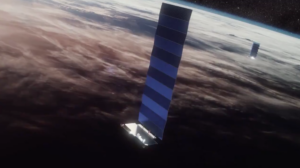NASA announced March 18 it had signed a Space Act Agreement with SpaceX regarding coordination of operations of the ISS and other NASA spacecraft with SpaceX’s growing fleet of Starlink satellites in low Earth orbit. The agreement, NASA said in a statement, is intended to “formalize both parties’ strong interest in the sharing of information to maintain and improve space safety.”
“With commercial companies launching more and more satellites, it’s critical we increase communications, exchange data, and establish best practices to ensure we all maintain a safe space environment,” Steve Jurczyk, NASA acting administrator, said in the statement.
According to the agreement, SpaceX will use the autonomous collision avoidance feature of its Starlink satellites to move then in the event of any close approaches with NASA spacecraft. That is intended, the agreement states, to avoid a case where both parties maneuvered.
“NASA has agreed to not maneuver in the event of a potential conjunction to ensure the parties do not inadvertently maneuver into one another,” the agreement states. “NASA will operate on the basis that the autonomous maneuvering capability of the Starlink satellites will attempt to maneuver to avoid conjunction with NASA assets, and that NASA will maintain its planned trajectory unless otherwise informed by SpaceX.”
The agreement outlines the roles and responsibilities of NASA and SpaceX regarding sharing information on orbital positions and maneuver plans. It requires SpaceX to notify NASA at least a week before each Starlink launch so NASA can determine if that mission poses any collision avoidance issues. SpaceX also agreed to launch Starlink satellites into initial orbits that do not come within five kilometers of the ISS or other NASA spacecraft. SpaceX will also avoid “any notifiable conjunctions” with the ISS in general, which NASA defines as a volume of space 50 by 50 by 4 kilometers, centered on the station.
The announcement didn’t explain the origins of the agreement, which was apparently drafted several months ago. The text of the agreement notes that SpaceX’s Starlink system has “over 600 assets currently in orbit,” a figure it exceeded months ago as it launches new satellites at a frenetic pace. SpaceX currently has 1,260 Starlink satellites in orbit, according to statistics maintained by spaceflight expert Jonathan McDowell.
NASA spokesperson J.D. Harrington told SpaceNews there was not a specific incident, such as a close approach by a Starlink satellite to a NASA spacecraft, that led to the agreement. “The technical teams from NASA and SpaceX have worked together for some time to ensure consistent and timely communications,” Harrington said. “This agreement came about as an offshoot of our work together on human and cargo spaceflight communications.”
SpaceX did not respond to a request for comment about the NASA agreement.
The company has long emphasized its use of automation on Starlink satellites to decide when to perform collision avoidance maneuvers. The company is not alone, though, as other companies planning megaconstellations are adopting similar approaches.
“Every operator I’ve talked to has a tremendous amount of automation in their systems,” said Ted Muelhaupt, principal director of the Aerospace Corporation’s Center for Orbital and Reentry Debris Studies, during a presentation at a March 9 workshop on space traffic management by the LRA Institute. “Effectively, these vehicles are on ‘auto-drive’ and the operators themselves may not know when a vehicle chooses to maneuver.”
While that may increase efficiency, he warned it makes it far more difficult to predict close approaches several days in the future since spacecraft may maneuver in what can seem to be an unpredictable fashion. “When these vehicles are doing autonomous maneuvers, small maneuvers, they are making the assumptions that went into avoiding them in the first place invalid,” he said. “If you put two large constellations near one another, all these get greatly magnified.”
In addition to collaboration on avoiding spacecraft close approaches, the agreement between NASA and SpaceX also covers efforts to reduce the brightness of Starlink satellites, which may interfere with astronomical observations. NASA said it will share “technical expertise and lessons learned to collaborate with SpaceX on developing approaches to monitoring and mitigating photometric brightness” of satellites, while SpaceX said it will share similar insights with NASA “to inform Agency guidance development.”



